

Persistent Memory for PowerEdge Servers Increase Memory Capacity and Reduce Memory TCO
Download PDFMon, 16 Jan 2023 13:44:19 -0000
|Read Time: 0 minutes
Summary
When Intel® launched their Optane™ persistent memory (PMEM) modules in 2019, we were eager to understand how they would perform when mixed with traditional DRAM DIMMs. Now that sufficient testing and analysis has been completed, we know that both memory types, PMEM and DRAM, have similar performance readings. This means that PowerEdge customers can increase total capacity or reduce TCO without impacting the total system performance. This DfD will discuss our test study conducted for PMEM and DRAM performance readings, and explain what opportunities this creates for PowerEdge customers.
Introduction
Dell Technologies offers support for Intel® Optane™ PMEM (Persistent Memory) for previous-generation and current-generation PowerEdge servers. This support for mixing PMEM with DRAM allows customers to increase their total memory capacity or lower TCO, while having memory persistence in application direct mode.
However, customers were concerned that mixing DRAM and PMEM would cause performance degradation. Dell Technologies decided to conduct internal testing to better understand if there is a negative performance impact when these two memory types are mixed.
Test Setup
A 4-socket PowerEdge R940 was configured with the following:
- 4 Intel Xeon 8280L CPUs
- PERC H740P adapter with 8GB of cache
- OS on 5 1.8TB HDDs (RAID 5)
- HANA on 12x800GB SAS SSD (RAID 5)
- SLES 15 OS
- HANA 2.0 Revision 41
As for the memory populated, the PowerEdge R940 supports up to 48 memory slots; 24 of which support PMEM drives. Therefore, the first 24 memory slots consist of 128GB DRAM, and the remaining 24 memory slots were divided into 3 test cases:
- Test Case 1: 128 GB DRAM
- Test Case 2: 128 GB PMEM
- Test Case 3: 512 GB PMEM
Results were achieved with SAP BW Edition for performance test based on the scenario defined in the SAP BW edition for SAP HANA Standard Application Benchmark [sap.com]. Measurements from 5+ test runs were normalized to avoid fluctuation.
Test Results – Relative Performance
Two test phases were performed. The first test phase measured the completion times required to load test data from the drives to the database. The times required to load over 2.5 billion records into an empty database were nearly identical, with PMEM taking only 1.8% longer to load than DRAM. This establishes that the load speeds of both memory types are nearly identical.
The second test phase measured the number of queries per hour performed in SAP HANA. As seen in Figure 1, the configuration loaded with 100% 128GB DRAM performed the best and is our baseline for PMEM comparison. The next
two configurations with 50% 128GB PMEM and 50% 512GB PMEM trailed closely behind, with only a -8.89% and -7.56% performance hit for each PMEM drive config, respectively. These readings establish that DRAM and PMEM have similar performance, so customers investigating PMEM as an alternative to DRAM should only see marginal performance degradation.
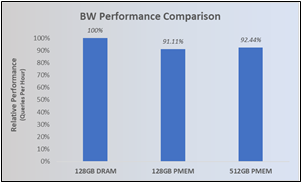
Figure 1 – Bar graph illustrating queries per hour in relative percentages for 128GB DRAM, 128GB PMEM and 512GB PMEM
PMEM Advantages
Reduce TCO
Customers can explore mixing DRAM and PMEM quantities to optimize the $/GB for their server needs. DRAM typically ranges from $41/GB - $64/GB, while PMEM ranges from $12/GB - $20GB, based on capacity size and current market pricing. This means that customers can reduce costs by up to 71% when populating the open 24 memory slots with supported PMEM modules! Figure 2 below illustrates the $/GB of various mixed DRAM and PMEM configurations in the PE R940:
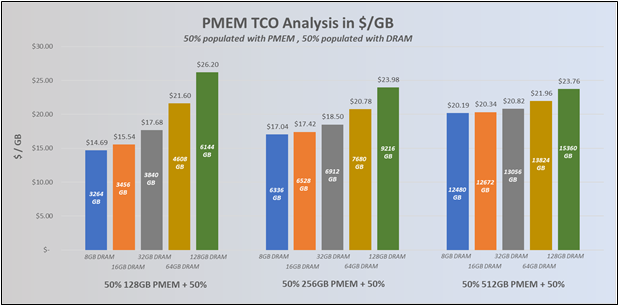
Figure 2 – Bar graph illustrating the $/GB and total capacities of various mixed DRAM and PMEM configurations on the PowerEdge R940
Increase Memory Capacity
Because PMEM has higher capacities than DRAM, users can boost their total memory capacity by populating their memory slots with 256GB or 512GB PMEM. In the case of our PE R940 test study, 24 memory slots are already occupied by 128GB DRAM. So, if the remaining 24 memory slots are populated with 256GB or 512GB PMEM, customers would see capacity gains of up to 50% and 150%, respectively.
Increase Memory Capacity AND Reduce TCO
Even more enticing is the fact that customers can increase their memory capacity, while also lowering their TCO. There are many mixed memory configurations that will give this “best of both worlds” return, but Figure 3 below shows one example on the PE R940. By replacing 24 of the 128GB DRAM with 512GB PMEM, users can increase total memory capacity by up to 150% while reducing memory TCO by up to 41.6%. Again, please keep in mind that TCO percentages are subject to change depending on capacity size and the current market pricing.
Calculations |
| Calculations |
| ||||||||||
GB (DRAM) | GB (PM) | PRICE | QTY | TOTAL GB | TOTAL $ | GB (DRAM) | GB (PM) | PRICE | QTY | TOTAL GB | TOTAL $ | ||
8 |
| $ 499.00 | 0 | 0 | $ - | 8 |
| $ 499.00 | 0 | 0 | $ - | ||
16 |
| $ 739.00 | 0 | 0 | $ - | 16 |
| $ 739.00 | 0 | 0 | $ - | ||
32 |
| $ 1,329.00 | 0 | 0 | $ - | 32 |
| $ 1,329.00 | 0 | 0 | $ - | ||
64 |
| $ 2,649.00 | 0 | 0 | $ - | 64 |
| $ 2,649.00 | 0 | 0 | $ - | ||
128 |
| $ 5,209.00 | 24 | 3072 | $125,016.00 | 128 |
| $ 5,209.00 | 48 | 6144 | $250,032.00 | ||
| 128 | $ 1,499.00 | 0 | 0 | $ - |
| 128 | $ 1,499.00 | 0 | 0 | $ - | ||
| 256 | $ 3,999.00 | 0 | 0 | $ - |
| 256 | $ 3,999.00 | 0 | 0 | $ - | ||
| 512 | $ 9,999.00 | 24 | 12288 | $239,976.00 | $ / GB |
| 512 | $ 9,999.00 | 0 | 0 | $ - | $ / GB |
Totals | 15360 | $364,992.00 | $ 23.76 | Totals | 6144 | $250,032.00 | $ 40.70 | ||||||
Figure 3 – Bar graph illustrating the $/GB and total capacities of various mixed DRAM and PMEM configurations on the PowerEdge R940
Conclusion
By conducting studies that highlight the performance impact of mixing DRAM and PMEM, Dell Technologies was able to conclude that the performance of each memory type was very similar, with nearly identical load times and only a slight performance hit for the number of queries run in SAP HANA. These findings provide customers adequate reassurance to invest in PMEM modules that can increase memory capacity, reduce TCO, or even both!
Related Documents

Top 5 Reasons to Migrate to the PowerEdge T550 from the Previous-Generation T440 and T640
Tue, 17 Jan 2023 08:25:05 -0000
|Read Time: 0 minutes
Summary
The Dell EMC PowerEdge T550 is the next-generation performance mainstream tower by Dell Technologies. By consolidating the most valuable features from the previous-generation T440 and T640, the T550 is offered as the successor intended to run performance use cases and workloads in medium businesses, Edge, ROBO and enterprise data centers. This DfD will inform readers on how decision making led to merging the T440 and T640 into the T550, as well as give five top reasons why customers will be excited to transition over to this new powerhouse - the T550.
Merging the T440 and T640
Development of the PowerEdge T550 heavily focused on aligning what it would offer to what customers actually used in ROBO, Edge, SMB, and enterprise datacenter environments. Sales data from the previous-generation T440 and T640 were often used to navigate decision-making and generally pointed to a clear, general consensus. A few examples are below:
- GPU attach rates on the more-capable T640 were rarely populated in full, resulting in under-utilized space
- Specific desirable features in the T640, such as NVMe support, were not present in the T440
- Top bin CPU support was not present in the T440
These observations allowed engineering to refine what the next performance mainstream PowerEdge tower would look like. By eliminating the less desirable features and keeping the most valuable ones, the T550 has essentially merged both of its predecessors into a handcrafted, next-generation powerhouse. The remainder of this DfD will highlight the top five reasons why we believe our customers will benefit from transitioning over to the T550, a few of which are direct results from the merger.
*Please note that the T640 lifecycle is extended to mid-2022 for customers who choose to stay on 2nd Generation Xeon®, and the T440 lifecycle is extended until mid-2023 for customers who choose to bridge from 2nd Generation Xeon® to 4th Generation Xeon®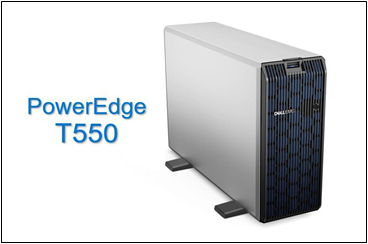
Figure 1 – Side angle of the sleek, new PowerEdge T550
Five Most Valuable Impacts
3rd Generation Intel® Xeon® Scalable Processors
The 3rd Generation Intel® Xeon® Scalable processor family was designed to generate higher productivity and operational efficiency for dense workloads, such as AI, ML/DL and HPC. In addition to full-stack support for the T550, various architectural design refinements have returned significant performance improvements across multiple benchmarks, including:
- SPECrate 2017 (a throughput measurement metric) observed a 57.1% performance improvement for Floating Point when compared to 2nd Generation Xeon, as published here
- SPECspeed 2017 (a time-based measurement metric) observed a 50.3% performance improvement for Floating Point when compared to 2nd Generation Xeon, as published here
- Gen-on-Gen performance improvement average of 1.46x, as observed by Intel
Top-of-the-line features are integrated into 3rd Generation Xeon Scalable CPUs to give users more functionality. Enhanced Speed Select Technology (SST) functionalities, including base frequency, core power, and turbo frequency, offers a finer control over CPU performance for cost optimization. Intel Software Guard Extensions (SGX) offers maximum privacy and protection by encrypting sections of memory to create highly secured environments to store sensitive data.
3200 MT/s Memory Speed
Memory speeds have risen by 20% over the previous-generation T440 and T640, increasing from 2666 MT/s to 3200 MT/s. Additionally, the number of supported memory slots has jumped from 6 to 8 – a 33% increase in DIMM capacity. Allowing more data to be stored in memory, with faster DIMM speeds, will significantly reduce data transfer times for memory-intensive workloads like databases, CRM, ERP, or Exchange.
PowerEdge Enterprise Features
The PowerEdge advantage lies within the robust environment offered to enterprise customers. The PowerEdge Raid Controller 11 (PERC11) now provides NVMe HW RAID, granting users the ability to back up data from their most powerful storage devices. In addition to hard drives, fans, PSUs, and Internal Dual SD Modules (IDSDM), hot-plug support is now also offered for front access BOSS (2x M.2 internal), allowing the server to keep running when a critical component swap is needed. Even the T550s smaller form factor (10% less volume than T440 and 15% less volume than T640) now allows GPUs to be used in tower format, so that max performance can be achieved whether in the datacenter or in the office closet.
Legacy Boot support has been deprecated by Intel and replaced with the superior UEFI Secure Boot (Unified Extensible Firmware Interface), which has better programmability, greater scalability, and higher security. UEFI Secure Boot also provides faster booting times and support for 9ZB, while legacy BIOS is limited to 2.2TB boot drives. Lastly, although not a newly supported feature, customers can continue to optimize server management with iDRAC9 (Integrated Dell Remote Access Controller), which provides administrators with an abundance of server operation information to a dashboard screen that can be remotely accessed and managed. Countless operational conditions are always monitored, giving small businesses more flexibility to allocate limited resources and manpower elsewhere.
PCIe Gen4
Support for five slots of PCIe Gen4, the fourth iteration of the PCIe standard, is now included. Compared to PCIe Gen3, the throughput per lane doubles from 8GT/s to 16GT/s, effectively cutting transfer times in half for data traveling from PCIe devices to CPU. This feature will be extremely effective for customers adopting dense components, like NVMe drives or GPUs.
MVP (Most Valuable Peripherals)
Decision making for peripheral support came as a direct result from the T440 and T640 merger. Sales data indicated what customers valued most, and the T550 achieved a perfectly balanced blend of storage, PCIe and GPU capability. To begin, the number of storage devices supported was met in the middle, with availability for up to 24x SAS/SATA drives (T440 maxed out at 16x, and the T640 maxed out at 32x). This also includes NVMe drives support, with the inclusion of an 8x SAS/SATA + 8x NVMe configuration! *Note that customers seeking 32x SAS/SATA drives can still leverage the T640 tower until mid-2022, or R740xd2 rack if that is a better suited solution.
The number of PCIe slots were also blended, with five slots available for x16 PCIe Gen4, and one slot available for x8 PCIe Gen3. This is a great compromise, as customers will still be receiving more total lanes (88 lanes on T550 vs. 64 lanes on T640). Lastly, after observing low GPU attach rates on the T640, the T550 offers up to 2x DW or 5x SW GPUs – a much more accurate representation of what customers have been using for AI/HPC workload support. The latest and greatest GPU models are now supported, including the NVIDIA T4, A10, A30 and A40. Lastly, NVLink bridging can now be utilized to create a high-bandwidth link between compatible GPUs! This will drive performance for workloads like databases, virtualization, and medium duty AI/ML.
Performance Comparison
Dell Technologies commissioned Grid Dynamics to validate the performance uplift for various T550 use cases when compared to the previous-generation T640. Figures 2-4 below illustrate just a few examples of the boosted performance seen on the T550. The full whitepaper can be seen here.
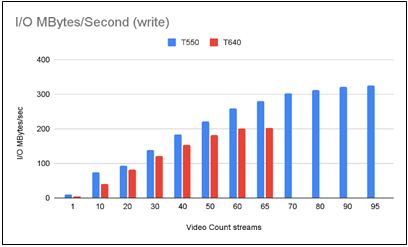
Figure 2 – I/O operations comparison for processing the same amount of retail video streams. The T550 does I/O writing 26.26% faster than T640.
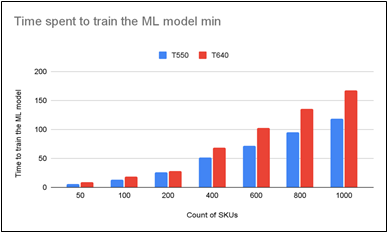
Figure 3 – Comparison of time spent to train an ML model depending on the number of SKUs for retail inventory decision making. The T550 uses 25.77% less time to train the ML model than T640.
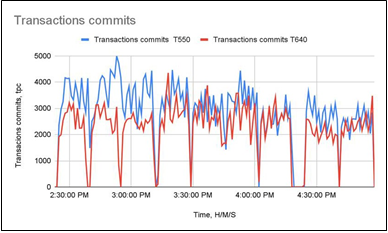
Figure 4 – Comparison of transactions committing speed when measuring database-related operations over a VM. The speed of transaction commits is 19.8% higher on the T550 compared to T640.
Final Words
The PowerEdge T550 has been handcrafted to offer a wide array of customers the most valuable features and support for performance workloads such as data analytic, virtualization, and medium duty AI/ML, in addition to more mainstream workloads such as collaboration, database, and CRM.

The New PowerEdge T350
Tue, 17 Jan 2023 07:40:19 -0000
|Read Time: 0 minutes
Summary
The Dell EMC PowerEdge T350 offers customers peak performance and enterprise features within a significantly smaller form factor – 37% smaller to be exact. The sleek new chassis was intentionally designed for the powerful T350 tower by shrinking the unused space inside - right-sizing the box so it can reside in smaller spaces that SMB, Edge and ROBO customers intend to deploy it at. This DfD was written to brief readers of the advantages brought to the PowerEdge T350, including improved performance, new features, and its smaller form factor.
Right-Sized for Deployment Anywhere
The new Dell EMC PowerEdge T350 chassis is 37% smaller than its predecessor, the T340. This decision was pioneered by feedback from customer feedback and sales data, which consistently pointed to one clear consensus – customers valued a smaller sized box.
This value proposition pushed our development team to forego the option of leveraging the T550 chassis design (to reduce cost) and to focus on developing a right-sized T350 chassis to best accommodate customers outside of the datacenter. By shrinking unoccupied space within the server, the dimensions reduced from 17.45” x 8.6” x 23.19” (T340) to 14.6” x 6.9” x 22” (T350) – a significant decrease in volume. What’s even more impressive is that no features or hardware support were removed to enable this change!
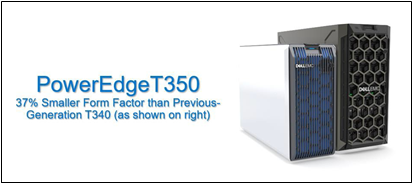
Figure 1 – Visual aid comparing the size of the T350 (left) and the T340 (right)
Right-sizing the mainstream T350 will be most advantageous to SMB customers deploying in remote offices, as this new, smaller solution is able to deliver higher performance technologies while in a quieter and more management-friendly enclosure. As explained in the next few paragraphs, many new features implemented onto the T350 will bring new levels of performance to SMB workloads like collaboration, file sharing, database, mail/messaging and web hosting.
Latest Hardware, New Features
Despite being 37% smaller, the PowerEdge T350 is packed with the latest hardware and new features to bring higher levels of performance, versatility, and optimization to your organization:
- The latest Intel® Xeon® E-2300 Processors offer a 19% increase of IPC (instructions per cycle) while also increasing IGP cores, L1 cache speed and L2 cache speed, allowing for up to 28% faster IO speeds when compared to the Xeon® E-2200 processor family.
- Supported UDIMM speeds have increased by 20% to 3200 MT/s and the max capacity per UDIMM has doubled from 16GB to 32GB. Having more memory at faster speeds will significantly reduce data transfer times, resulting in increased productivity.
- Up to 8x 2.5” or 3.5” SATA/SAS drives can be hosted on the backplane. Additionally, up to 2x M.2 drives are now hot-swappable with Dell Technologies BOSS-S2 card, allowing the server to keep running when a critical component swap is needed.
- Support for twenty lanes of PCIe Gen4 will double I/O throughput from 8GT/s to 16GT/s, effectively cutting transfer times in half for data traveling from storage to CPU.
In addition to the latest hardware and new feature support, customers will always get the high- quality enterprise features that the PowerEdge brand is known for, including:
- iDRAC9 which provides administrators with an abundance of server operation information to a dashboard screen that can be remotely accessed and managed.
- UEFI Secure Boot which has better programmability, scalability, security, booting speeds, feature support and user-friendliness than legacy BIOS.
- Redundant fans, PSUs, and hard drives
- Storage controllers that support HW RAID for SATA, SAS and NVMe interfaces
Performance Improvements
Dell Technologies ran internal testing comparing the T350 and T340 SPECrate® 2017_int_base results, which measures the ability to process identical programs on each of its available threads in parallel (or throughput, in layman’s terms). Both configurations were identical with the processor being the independent variable. The PowerEdge T350 used the latest Intel® Xeon® E-2300 processors while the older PowerEdge T340 used Intel® Xeon® E-2200 processors. As seen in Figure 2 below, each processor SKU from top bin to bottom bin observed a performance increase ranging from 14.8% to 32.3%. More information on these studies can be read here.
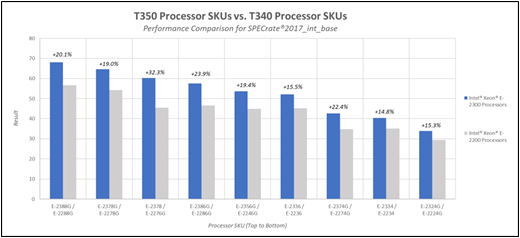
Figure 2 –SPECrate® 2017_int_base results for T350 CPUs (blue) vs. T340 CPUs (gray)
Dell Technologies also commissioned Grid Dynamics to carry out performance testing in retail and VDI environments to simulate tangible customer use-cases. Figure 3 below illustrates that, on average, the PowerEdge T350 performs I/O operations 36.1% faster than the T340 for the same amount of video streams. Figure 4 below illustrates that, on average, the PowerEdge T350 speed of transaction commits for the same size database is 37% higher than the T340. The scientific report can be read here and the executive summary can be read here.
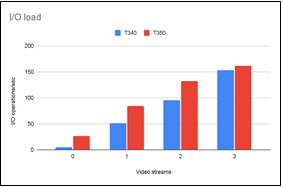
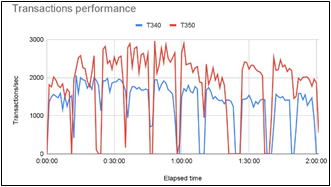
Figure 4 – Comparison of transactions committing speed
Conclusion
The Dell EMC PowerEdge T350 offers customers peak performance and new enterprise features within a right-sized form factor, so it can reside in smaller spaces to drive business growth where SMB, Edge and ROBO customers intend to deploy it at.


